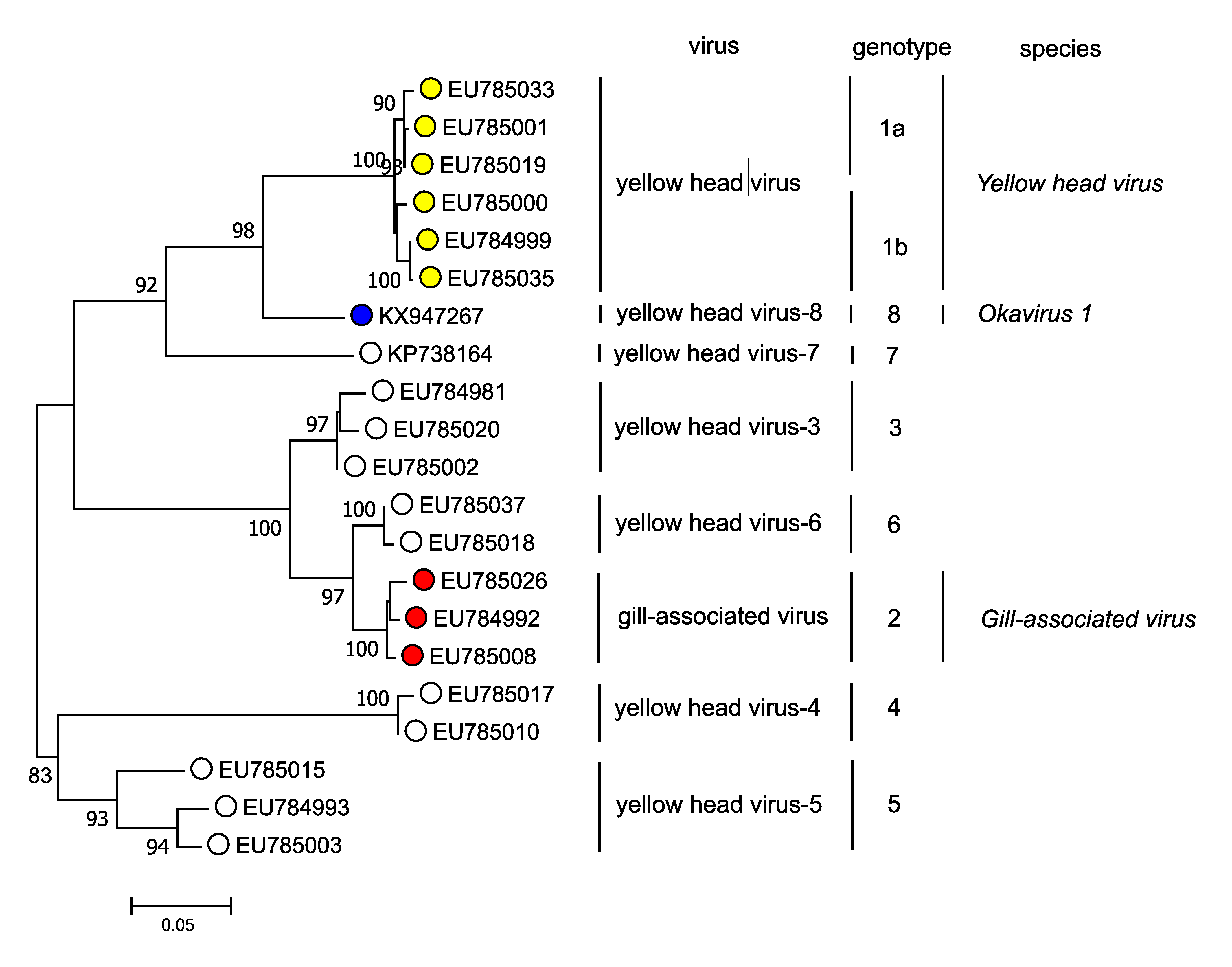Roniviridae on:
[Wikipedia]
[Google]
[Amazon]
''Okavirus'' is a genus of enveloped positive-strand RNA viruses which infect
 The genus contains one subgenus with three species. Species are listed by their scientific name and followed by the exemplar virus of the species:
* ''
The genus contains one subgenus with three species. Species are listed by their scientific name and followed by the exemplar virus of the species:
* ''
ICTV Report: ''Roniviridae''
{{Taxonbar, from=Q3775810, from2=Q7365724, from3=Q57751806, from4=Q57754796 Roniviridae Virus genera
crustacean
Crustaceans (from Latin meaning: "those with shells" or "crusted ones") are invertebrate animals that constitute one group of arthropods that are traditionally a part of the subphylum Crustacea (), a large, diverse group of mainly aquatic arthrop ...
s. Host organisms are mostly shrimp
A shrimp (: shrimp (American English, US) or shrimps (British English, UK)) is a crustacean with an elongated body and a primarily Aquatic locomotion, swimming mode of locomotion – typically Decapods belonging to the Caridea or Dendrobranchi ...
. Viruses associated with the genus include: gill-associated virus (GAV) which causes reddening, biofouling
Biofouling or biological fouling is the accumulation of microorganisms, plants, algae, or small animals where it is not wanted on surfaces such as ship and submarine hulls, devices such as water inlets, pipework, grates, ponds, and rivers that ...
with exoparasites, emaciation, and massive mortality; and yellow head virus (YHV) which causes yellow head, arrest of feeding, and massive mortality. The name is derived from the 'Oka' or lymphoid organ in which the viruses are commonly detected and in which pathology occurs during acute infections. Lymphoid organs are anatomical structures common to penaeid shrimp
Penaeidae is a family of marine crustaceans in the suborder Dendrobranchiata, which are often referred to as penaeid shrimp or penaeid prawns. The Penaeidae contain many species of economic importance, such as the tiger prawn, whiteleg shrimp, ...
. There are three species in this genus.
Structure
Viruses in the genus ''Okavirus'' are enveloped, withbacilliform
Bacterial cellular morphologies are the shapes that are characteristic of various types of bacteria and often key to their identification. Their direct examination under a light microscope enables the classification of these bacteria (and archaea ...
geometries, and helical symmetry. The diameter is around 20–30 nm.
Genome
Genomes are linear and non-segmented, around 26 kb in length.Life cycle
Entry into the host cell is achieved by attachment to host receptors, which mediatesendocytosis
Endocytosis is a cellular process in which Chemical substance, substances are brought into the cell. The material to be internalized is surrounded by an area of cell membrane, which then buds off inside the cell to form a Vesicle (biology and chem ...
. Replication follows the positive stranded RNA virus replication model. Positive stranded RNA virus transcription is the method of transcription. Crustaceans and mostly prawns serve as the natural host. Transmission routes are ingestion.
Taxonomy
 The genus contains one subgenus with three species. Species are listed by their scientific name and followed by the exemplar virus of the species:
* ''
The genus contains one subgenus with three species. Species are listed by their scientific name and followed by the exemplar virus of the species:
* ''Tipravirus
''Okavirus'' is a genus of enveloped positive-strand RNA viruses which infect crustaceans. Host organisms are mostly shrimp. Viruses associated with the genus include: gill-associated virus (GAV) which causes reddening, biofouling with exopara ...
''
** ''Okavirus branchiae'', Gill-associated virus
''Okavirus'' is a genus of enveloped positive-strand RNA viruses which infect crustaceans. Host organisms are mostly shrimp. Viruses associated with the genus include: gill-associated virus (GAV) which causes reddening, biofouling with exopara ...
** ''Okavirus flavicapitis'', Yellow head virus
** ''Okavirus orientale'', Yellow head virus type 8 (also called Yellow head virus genotype 8 and Yellow head virus 8)
References
External links
ICTV Report: ''Roniviridae''
{{Taxonbar, from=Q3775810, from2=Q7365724, from3=Q57751806, from4=Q57754796 Roniviridae Virus genera